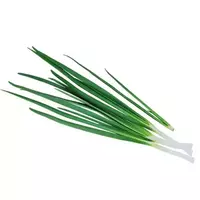Welsh onion

The batoon onion belongs to the onion family and belongs to the genus Onion. In addition to the main name of the batun onion (in Latin Allium fistulosum), the plant is called Tatar, as well as pipe onions. The batoon onion is believed to be native to Asia. However, in the wild, the plant grows in China, Siberia and Japan. The batun onion differs in its appearance from the closest relatives from the subspecies green onions. The stem of the onion sometimes reaches one meter in height. The leaves of the batoon onion are shaped like a pipe, hence the second name of the species.
The plant blooms with a globular umbrella, which consists of small white flowers. Currently, there are three main varieties of onion-batun - Japanese, Russian and Chinese. Species of the plant differ in their place of growth. There are no particular differences in taste between the subspecies of batun onion. It is noteworthy that batun onions belong to plants that are able to tolerate subzero temperatures. Batun onions are sown once and the plant grows in the same place for several years. The batoon onion is able to withstand temperatures up to -10 C.
The first harvest of batun onions is harvested in late May or early June of the month. Onion leaves are cut, but false bulbs in the form of a continuation of the stem are not removed from the ground. Another month later, the second crop of the plant is harvested. If you skip the harvest date of green onion-batun feathers, onion arrows are formed that are not suitable for consumption. Batun onions produce three crops per season, so onion leaves are last cut in August. It is believed that up to 2 tons of green leaves of onion-batun can be harvested from one hectare.
At the end of summer, arrows with seeds and remaining onion greens are cut off. Batoon onions have several advantages over the common bulb species. Batun can grow in one place up to 6 years, and also ripens 20 days earlier than bulb onions. In cooking, leaves and stems of batun onions are used. In summer, it is better to eat fresh onion greens, which are enriched with a large amount of vitamins, minerals and other biologically active components.
The chemical composition of batun onions contains twice as much vitamin C as in the bulb form of the plant. In addition, onions contain vitamins of group A, PP and B, as well as iron, potassium and magnesium. The benefits of batun onions are the content of carotene, ascorbic acid, essential oil, thiamine and riboflavin. Green leaves of batun onions are just a treasure trove of vitamins. However, in dried form, a sufficient number of useful compounds are preserved in the composition of the batun onion, which bring tangible benefits to the human body.
luka batuna 34 kKal
Energy value of onion-batun (Ratio of proteins, fats, carbohydrates - ju):
Proteins: 1.3 g (~ 5 kCal)
Fats: 0.1 g (~ 1 kCal)
Carbohydrates: 3.2 g (~ 13 kCal)
Energy ratio (bj | y): 15% | 3% | 38%
 Español
Español Français
Français Português
Português Русский
Русский 简体中文
简体中文 繁體中文
繁體中文 日本語
日本語 한국어
한국어 العربية
العربية Türkçe
Türkçe Қазақ
Қазақ Deutsch
Deutsch Italiano
Italiano Українська
Українська
